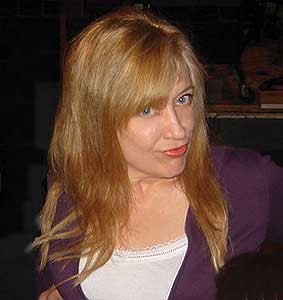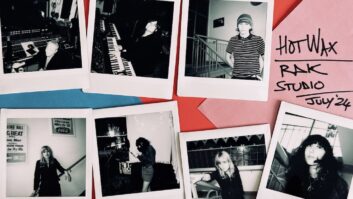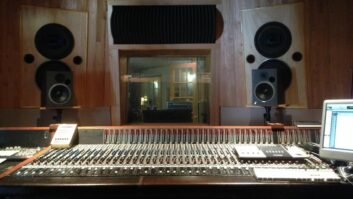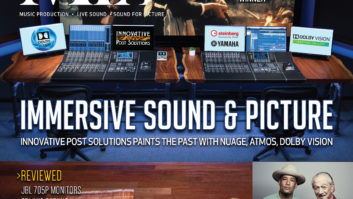
How many times have we set up a fire hazard of Mexican prayer candles and tapestries to give an anxious vocalist just the right “vibe” to spit out a decent vocal performance? Making the singer as comfortable (or as uncomfortable) as possible in the studio is one of the secrets to getting a great vocal take. As much as I love them all, singers are often overly sensitive characters that need to be coddled. Forget the fact that we are going to comp the hell out of them later and tweak them with a dozen digital processors and tuners, you still have to treat those singers like an important part of the project — I mean the most important part. Ahem.
The recording studio can often be intimidating to a singer, so occasionally it’s necessary to try techniques and equipment not traditionally used for vocal recording — just to stop the singer from feeling self-conscious. That’s where the AKG C 1000 microphone came in on the Tool sessions. It was not my first choice. It was not even on the list of choices because I had never used it for vocals — ever.
I was looking for the sound of a Neumann U67 on Maynard James Keenan’s voice, but because the little troll squats and shouts into the floor when he sings, it was difficult to suspend a Neumann U67 in the right position for a vocal take. We tried it, spending several hours adjusting the mic so it was a foot off the floor facing upward to capture Maynard’s verbal regurgitation. But ultimately it failed. This was 1993, and I’d seen Tool play in local clubs many times. It was obvious that these first studio vocal takes lacked the fire of Maynard’s stage performances, so we looked for other options to harness that intense stage energy. I knew we needed to use a handheld but felt cheated that I couldn’t use the most expensive mic in Grandmaster Studio’s arsenal for the task (which was the U67 at the time). I wanted quality vocals that were crystal-clear. I wanted the listener to experience every ounce of pain this singer could deliver.

The vocal sessions for Undertow were all about making singer Maynard James Keenan comfortable—and uncomfortable—in the studio. He ended up on an AKG C 1000 condenser, not a typical vocal choice.
The handheld dynamic mics we tried seemed dull and unwieldy, but Maynard immediately sang better into them. The C 1000 was actually Maynard’s suggestion. This mic’s not generally meant to be handheld, but after wrapping it in foam and duct tape to reduce the handling noise, it performed surprisingly well on his vocals. Because it was a condenser, it retained most of the sparkle of the U67 and Maynard could grab it in his fist and smack the mic around. Ultimately, the C 1000 was the workhorse on the sessions, but we did use the Neumann U67 for the more intimate passages with a UREI 1176 compressor cranked way up to expose all the little details in Maynard’s voice.
Tool’s Undertow album is filled with blood-vessel-popping screams, like on the song “Crawl Away.” I had heard them in rehearsals, I heard them onstage. But in the studio, Maynard’s screams were lackluster, even with the perfect complement of the C 1000. After several attempts at one of those 10-second screams without a good take, and with his voice obviously wearing thin, I finally asked him to go outside and run around the block five times. This would make him furious, but after doing it he nailed those screams. He was pissed and you could hear it in his voice. The lesson here? Sometimes it’s necessary to make the singer as un-comfortable as possible to get the right performance!
Handheld condenser mics were mainly developed for live performance applications, yet they are fantastic additions to a recording studio’s collection. Today, there are many options for crystal-clear vocal recording with handheld condensers. I am most impressed with Audio-Technica’s AE3300, the handheld version of its AT4033, a popular mid-priced vocal mic in many commercial studios. The AE3300 has an extra level of warmth on a male vocal and it adds a measure of depth on a female vocal without sacrificing the clean top of a good studio condenser.
AKG also currently has two excellent handheld condensers, the C5 and the D5. And although not really meant to be handheld, AKG’s C 1000 is a good, relatively inexpensive condenser that’s powered by a 9-volt battery with an on/off switch. The main complaint about it is the mic battery always seems to be dead because someone always leaves the switch on. Hmpf! Luckily, it runs on phantom power, too. I’ve heard how well a pair of these C 1000s do as overhead mics on drums, especially when the drummer is hi-hat- and cymbal-happy, because they are a little bit darker than other condensers. They also do well on acoustic guitars, in pairs or solo.
My AKG C 1000 is still as decent as ever today, even with all the scars and war wounds from its intense studio history. It wasn’t my first choice, but it is vastly more important to give the singer what he needs to give you that blistering vocal performance.
Sylvia Massy is the unconventional producer and engineer of artists including Tool, System of a Down, Johnny Cash, Red Hot Chili Peppers, Tom Petty and Prince. She is a member of the NARAS P&E Wing Steering Committee and Advisory Boards, and is a resident producer at RadioStar Studios in Weed, Calif.






